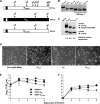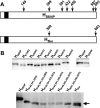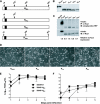Canine distemper viruses expressing a hemagglutinin without N-glycans lose virulence but retain immunosuppression
- PMID: 20042514
- PMCID: PMC2826070
- DOI: 10.1128/JVI.01813-09
Canine distemper viruses expressing a hemagglutinin without N-glycans lose virulence but retain immunosuppression
Abstract
Paramyxovirus glycoproteins are posttranslationally modified by the addition of N-linked glycans, which are often necessary for correct folding, processing, and cell surface expression. To establish the contribution of N glycosylation to morbillivirus attachment (H) protein function and overall virulence, we first determined the use of the potential N-glycosylation sites in the canine distemper virus (CDV) H proteins. Biochemical characterization revealed that the three sites conserved in all strains were N glycosylated, whereas only two of the up to five additional sites present in wild-type strains are used. A wild-type virus with an H protein reproducing the vaccine strain N-glycosylation pattern remained lethal in ferrets but with a prolonged course of disease. In contrast, introduction of the vaccine H protein in the wild-type context resulted in complete attenuation. To further characterize the role of N glycosylation in CDV pathogenesis, the N-glycosylation sites of wild-type H proteins were successively deleted, including a nonstandard site, to ultimately generate a nonglycosylated H protein. Despite reduced expression levels, this protein remained fully functional. Recombinant viruses expressing N-glycan-deficient H proteins no longer caused disease, even though their immunosuppressive capacities were retained, indicating that reduced N glycosylation contributes to attenuation without affecting immunosuppression.
Figures





Similar articles
-
Canine distemper virus epithelial cell infection is required for clinical disease but not for immunosuppression.J Virol. 2012 Apr;86(7):3658-66. doi: 10.1128/JVI.06414-11. Epub 2012 Jan 25. J Virol. 2012. PMID: 22278252 Free PMC article.
-
Persistent and Severe Viral Replication in PBMCs with Moderate Immunosuppression Served an Alternative Novel Pathogenic Mechanism for Canine Morbillivirus.Microbiol Spectr. 2023 Feb 14;11(1):e0406022. doi: 10.1128/spectrum.04060-22. Epub 2022 Dec 19. Microbiol Spectr. 2023. PMID: 36533959 Free PMC article.
-
Characterization of a new dog isolate of canine distemper virus from China.Acta Virol. 2011;55(4):303-10. doi: 10.4149/av_2011_04_303. Acta Virol. 2011. PMID: 22149495
-
Tropism and molecular pathogenesis of canine distemper virus.Virol J. 2019 Mar 7;16(1):30. doi: 10.1186/s12985-019-1136-6. Virol J. 2019. PMID: 30845967 Free PMC article. Review.
-
Morbillivirus Experimental Animal Models: Measles Virus Pathogenesis Insights from Canine Distemper Virus.Viruses. 2016 Oct 11;8(10):274. doi: 10.3390/v8100274. Viruses. 2016. PMID: 27727184 Free PMC article. Review.
Cited by
-
Isolation and sequence analysis of the complete H gene of canine distemper virus from domestic dogs in Henan Province, China.Arch Virol. 2019 Aug;164(8):2153-2158. doi: 10.1007/s00705-019-04298-7. Epub 2019 May 27. Arch Virol. 2019. PMID: 31134355 Free PMC article.
-
Canine distemper virus epithelial cell infection is required for clinical disease but not for immunosuppression.J Virol. 2012 Apr;86(7):3658-66. doi: 10.1128/JVI.06414-11. Epub 2012 Jan 25. J Virol. 2012. PMID: 22278252 Free PMC article.
-
Phylogenetic analysis of the haemagglutinin gene of canine distemper virus strains detected from giant panda and raccoon dogs in China.Virol J. 2013 Apr 8;10:109. doi: 10.1186/1743-422X-10-109. Virol J. 2013. PMID: 23566727 Free PMC article.
-
Canine distemper spillover in domestic dogs from urban wildlife.Vet Clin North Am Small Anim Pract. 2011 Nov;41(6):1069-86. doi: 10.1016/j.cvsm.2011.08.005. Vet Clin North Am Small Anim Pract. 2011. PMID: 22041204 Free PMC article. Review.
-
First complete genome sequence and molecular characterization of Canine morbillivirus isolated in Central Brazil.Sci Rep. 2021 Jun 22;11(1):13039. doi: 10.1038/s41598-021-92183-2. Sci Rep. 2021. PMID: 34158515 Free PMC article.
References
-
- Bagai, S., and R. A. Lamb. 1995. Individual roles of N-linked oligosaccharide chains in intracellular transport of the paramyxovirus SV5 fusion protein. Virology 209:250-256. - PubMed
-
- Baron, M. D. 2005. Wild-type Rinderpest virus uses SLAM (CD150) as its receptor. J. Gen. Virol. 86:1753-1757. - PubMed
-
- Bartz, R., U. Brinckmann, L. M. Dunster, B. Rima, V. ter Meulen, and J. Schneider-Schaulies. 1996. Mapping amino acids of measles virus hemagglutinin responsible for receptor (CD46) downregulation. Virology 224:334-337. - PubMed
Publication types
MeSH terms
Substances
Grants and funding
LinkOut - more resources
Full Text Sources
Other Literature Sources

